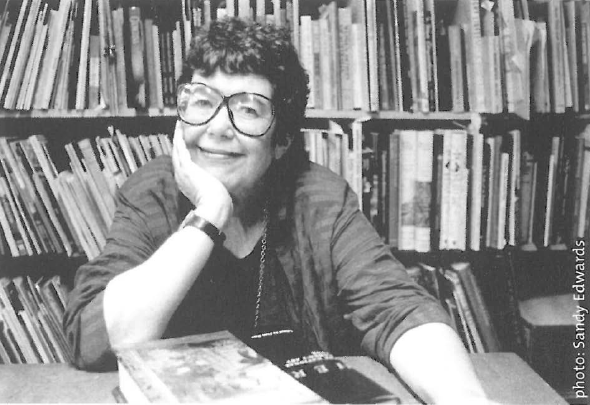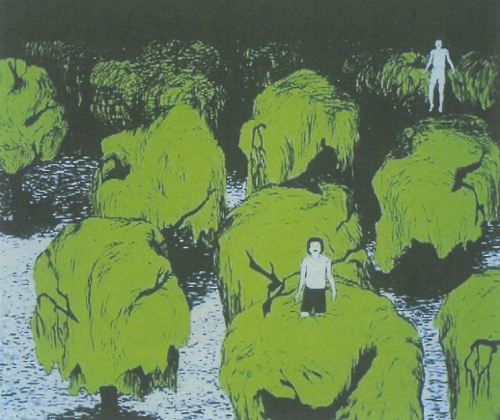
Joan Kerr (Eleanor Joan Lyndon) created new paradigms of scholarship with the two inclusive collaborative projects The Dictionary of Australian Artists (1992) and Heritage: The National Women's Art Book (1995). Both projects exploded preconceptions of the nature of and developments in Australian art history and culture.
Born in Sydney, Joan spent her childhood in Brisbane and attended the University of Queensland. In 1960, the same year she completed an honours degree in English, she married James Semple Kerr. It is impossible to imagine Joan's career without the support and inspiration of her husband. They were not only partners but scholars together.
In 1961, Joan briefly worked as a journalist for ACP. She later claimed that this experience gave her the foundations of her open and clear writing style.
She had two children, Tamsin (1962) and James (1963). In 1966 while the Kerr family was living in London, Joan enrolled in a certificate course in the History of Art at the Courtauld Institute and she also studied under the legendary architectural historian Sir Nikolaus Pevsner at Birbeck College. In 1969 the Kerrs returned to Australia where they both became full time students in Art and Architectural History at the University of Sydney.
James was to become a leading international figure in conservation and heritage studies, while Joan continued her studies in art history. Her first book (with James Broadbent) Gothick Taste in the Colony of New South Wales, was published in 1980. It is still regarded as the definitive study in this field. Her interest in Gothic revival took her to York University, where she completed her PhD on Church Architecture in NSW 1788-1888.
I first met Joan in 1978 when she was tutoring at the Australian National University. Her enthusiasm was extraordinary, infectious and inspiring. She did not allow traditional academic methodologies to restrict her interpretation or vision. Always questioning standards, orders and hierarchies, she was never limited by the orthodox approaches and methodologies of art and culture.
In 1981, while lecturing at the University of Sydney, she began to write, direct and coordinate The Dictionary of Australian Artists: Painters, sketchers, photographers and engravers to 1870. This work allowed a tectonic shift in the conceptions of Australian art and culture of the nineteenth century by examining the work of all (named) makers of two dimensional visual art. Where there was once a vast lacuna, Joan and her dedicated band of researchers (in particular, senior research assistant Candice Bruce) revealed the rich textures and sheer energy and breadth of art practice in Australia. The Dictionary is now one of the great research tools of Australian cultural history.
Joan was promoted to Associate Professor in 1985. In 1993, after the Dictionary was published, she was appointed to the College of Fine Arts, UNSW as Visiting Professor. Here she created Heritage: The National Women's Art Book. Another extraordinary collaborative publication (the biographies were co-edited by senior research assistant Anita Calloway). this text explored the histories of 500 works by women artists. To coincide with the publication, and to celebrate the 20th anniversary of International Women's Year, Joan negotiated for every Australian public gallery to exhibit only works by women for a set period, an enormous project coordinated by Jo Holder. An anthology of essays, Past Present, (edited by Kerr and Holder) linked this huge project to the history of exhibiting women's art in Australia.
In 1997, Joan's appointment as founding professor of the ANU's Centre for Cross-Cultural Research allowed her to return to another of her passions - artists who worked as illustrators. This resulted in Artists and Cartoonists in Black and White: The Most Public Art, an exhibition held simultaneously at the State Library of New South Wales and the S.H. Ervin Museum and Art Gallery at the National Trust. Featuring over 500 works and co curated with Jo Holder and myself, this was the first time that there had been systematic review and exhibition of the State Library's collection of over 70,000 original works on paper. This exhibition gave art historical rigour to an area of Australian visual culture long regarded as peripheral to serious museological, critical and theoretical consideration.
The wealth of material uncovered by this research led to the exhibition and book Human Scale in Architecture: George Molnar, a project with a subtext of sustainable urban development. Her most recent research concentrated specifically on black and white work by Aboriginal artists. In 2003, as a part of the Dictionary of Australian Artists on-line project, she returned to COFA as Visiting Professor.
Joan dedicated her time, energy and expertise to many causes, including The Historic Houses Trust of NSW, National Portrait Gallery, Society of Architectural Historians (ANZ), Art Association of Australia & New Zealand, Blake Society for Religious Art, National Trust of Australia, Royal Australian Historical Society, and the Women's Art Register. She was also one of the founding members of AAAR! (Australian Artists Against Racism) in 1997, the year of the emergence of Pauline Hanson and neo conservative agendas. She was elected a fellow of the Australian Academy of the Humanities in 1993 and in 1995 was (with James) awarded the National Trust Senior Heritage Award. She was particularly delighted to become only the second woman in more than a century to be granted an Honorary Fellow of the Royal Australian Historical Society.
Last year, after she was diagnosed with cancer, the Historic Houses Trust (Peter Watts and Dinah Dysart) organised a dinner in her honour at Government House. Talks of her contribution were given by Jill Wran, Jack Mundy, Candice Bruce, Virginia Spate and Vivienne Binns. It was a remarkable gathering of curators, historians, artists, politicians and activists to celebrate the person who understood that the fabric of art and life are intermingled.
Later this year Sydney University's Power Publications will publish A Singular Voice. This collection of Joan Kerr's essays will continue her legacy in architectural and art history.












